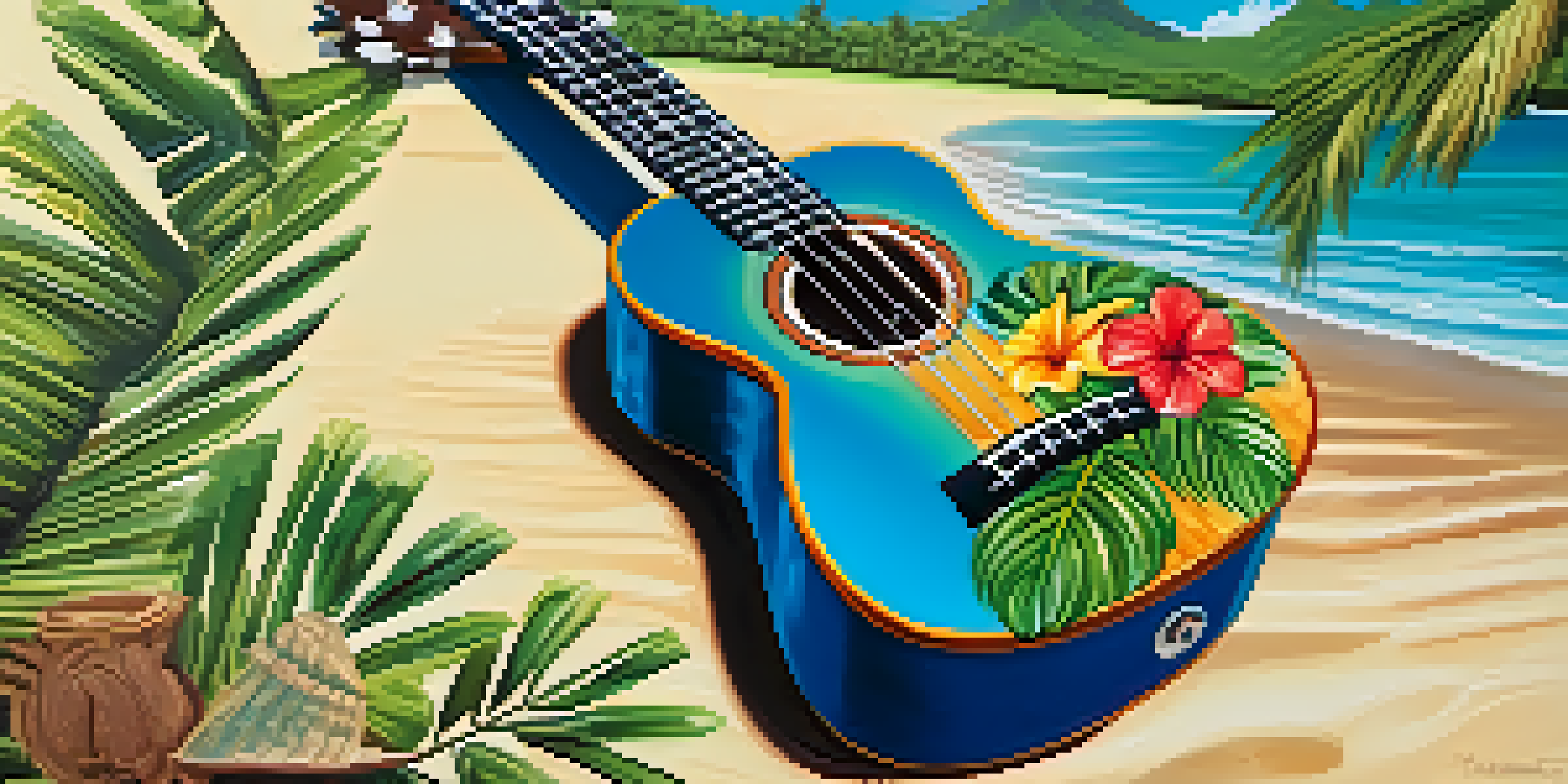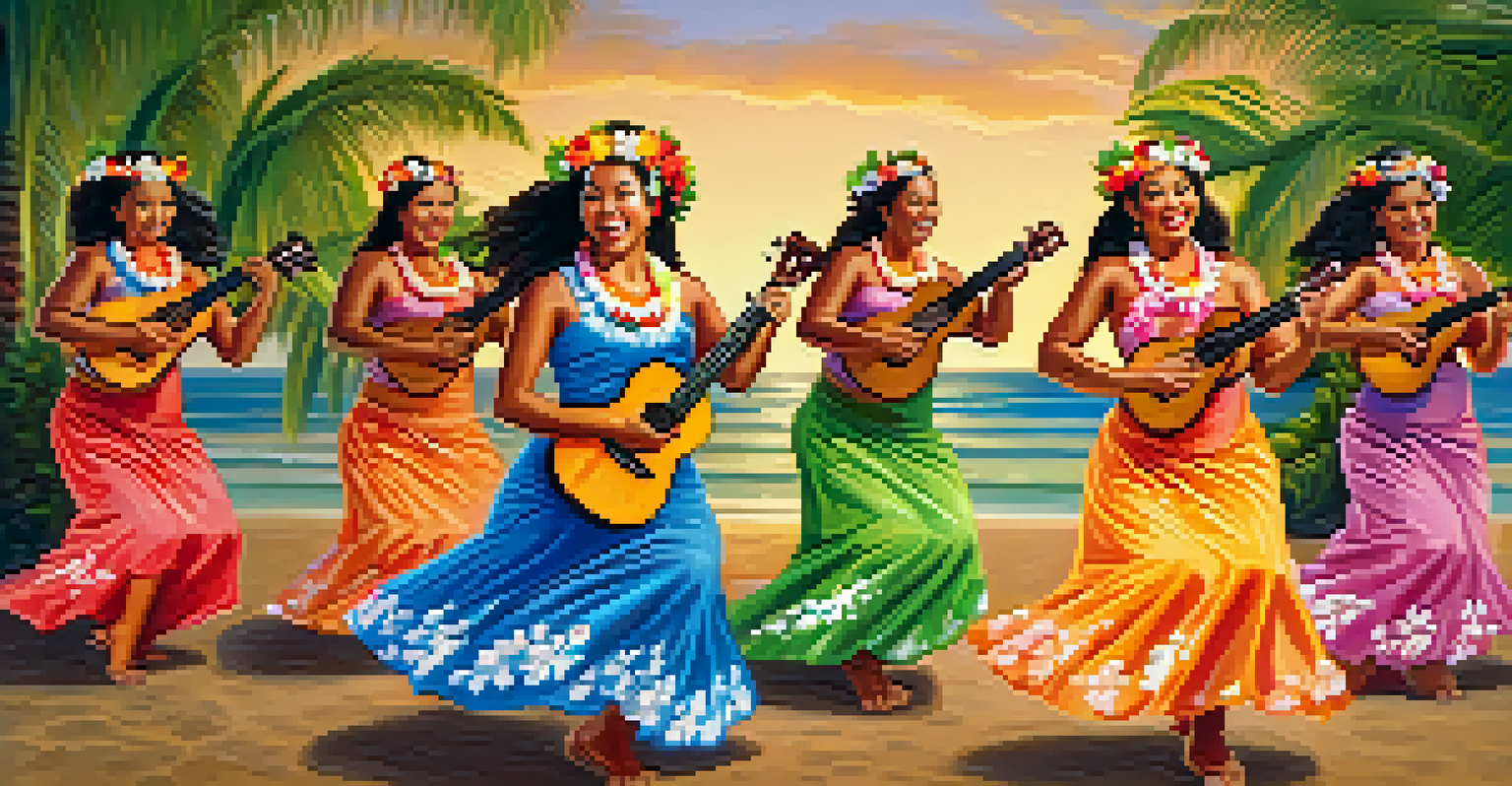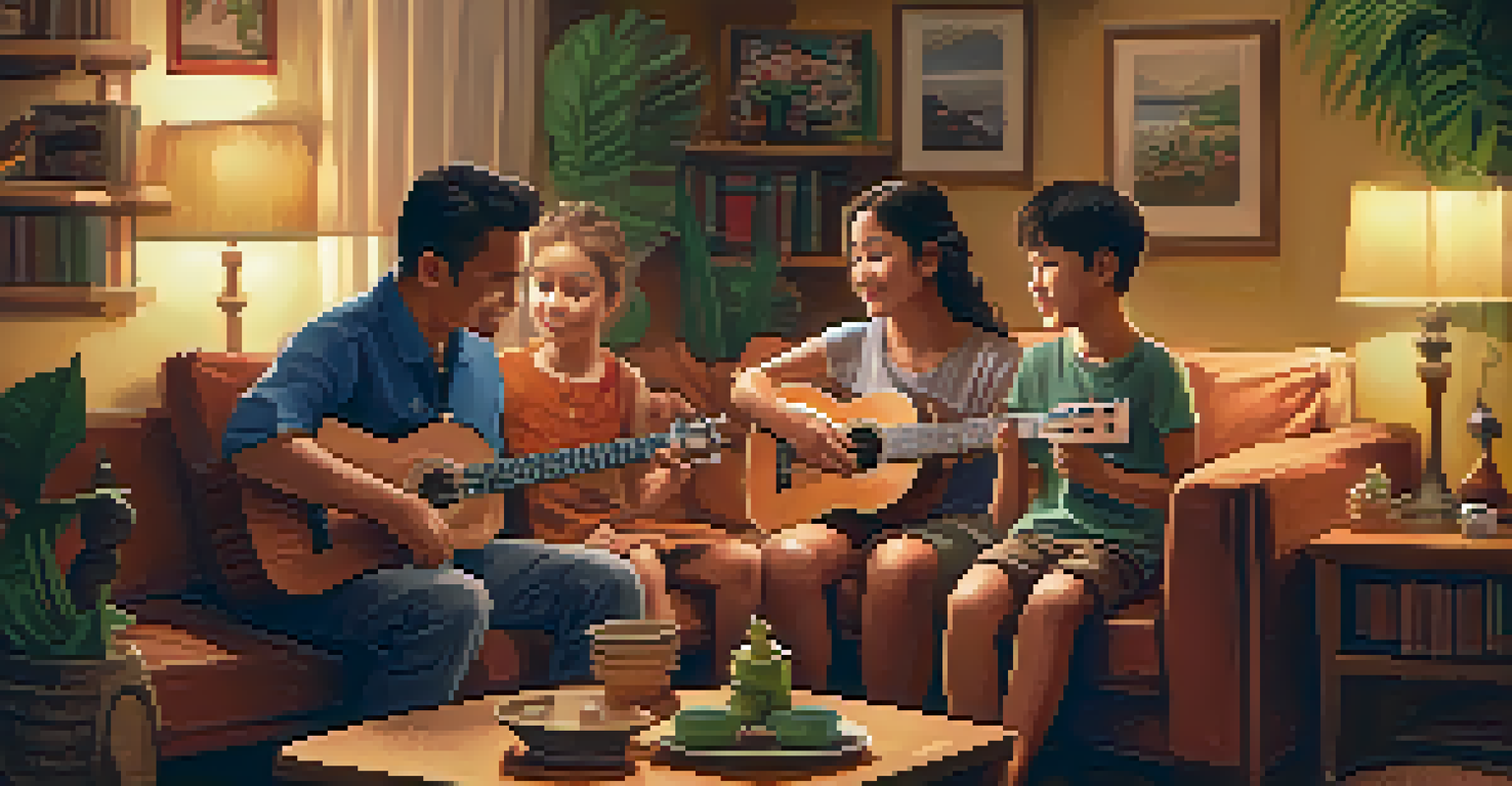The Ukulele's Role in Traditional Hawaiian Hula Dance

The Ukulele: A Brief History and Its Hawaiian Roots
The ukulele is a four-stringed instrument that originated in Portugal but found its true home in Hawaii. Introduced in the late 19th century, it quickly became a symbol of Hawaiian music and culture. Its cheerful sound and approachable nature made it popular among locals and visitors alike, contributing to its integration into traditional hula performances.
The ukulele is the instrument of joy, and its melodies echo the spirit of aloha.
The name 'ukulele' translates to 'jumping flea,' a nod to the way the fingers move over the strings. This lively instrument perfectly complements the fluid movements of hula, creating a harmonious blend of music and dance. As hula evolved, so did the ukulele's role, transitioning from a solo instrument to an essential part of group performances.
Today, the ukulele is synonymous with Hawaiian identity, representing the spirit and joy of the islands. Its lightweight design and playful tone have made it accessible for musicians of all ages, encouraging a vibrant ukulele culture that continues to thrive alongside traditional hula.
The Connection Between Ukulele and Hula Dance Movements
Hula dance is not just about movement; it tells stories through gestures, expressions, and rhythm. The ukulele's strumming patterns and melodies provide a musical backdrop that enhances these narratives. As dancers move, the upbeat tempo of the ukulele often reflects the light-hearted tales being portrayed, creating a dynamic interplay between music and motion.

For instance, when a dancer sways gracefully, the gentle strumming of the ukulele mimics the natural flow of the ocean waves. This connection between sound and movement allows the audience to feel the emotions conveyed in the performance. The syncopated rhythms of the ukulele also encourage improvisation, giving dancers the freedom to express themselves uniquely.
Ukulele: Heart of Hawaiian Culture
The ukulele is a symbol of Hawaiian music, enhancing traditional hula with its joyful sound and cultural significance.
Moreover, the ukulele's role extends beyond just accompaniment; it often serves as a solo instrument during hula performances. This allows for moments of introspection, where the music takes center stage, inviting the audience to connect with the story on a deeper level. The synergy between the ukulele and hula creates a rich cultural experience that captivates all who witness it.
Cultural Significance of the Ukulele in Hawaiian Traditions
The ukulele is more than just an instrument; it holds significant cultural importance in Hawaiian traditions. It is often used in ceremonies, celebrations, and gatherings, serving as a bridge between generations. Families pass down the love for the ukulele, fostering a sense of community and belonging that is deeply rooted in Hawaiian culture.
Music is the shorthand of emotion, and the ukulele expresses the heart of Hawaiian culture.
In hula, the ukulele enhances the storytelling aspect of the dance, allowing for a deeper connection to Hawaiian mythology and history. Traditional chants, known as 'mele,' often accompany hula performances, and the ukulele provides a melodic foundation for these songs. This fusion of music and dance helps preserve Hawaiian heritage, ensuring that stories and values are passed down through time.
Additionally, the ukulele has become a symbol of Hawaiian hospitality. Its cheerful sounds invite everyone to join in the celebration, creating an atmosphere of joy and togetherness. This sense of community is vital in hula, as it emphasizes the importance of collective participation in preserving and sharing Hawaiian culture.
Learning the Ukulele: A Gateway to Hula Dance
For many, learning the ukulele serves as a gateway to exploring Hawaiian hula dance. The instrument's simplicity makes it an excellent choice for beginners, encouraging more people to pick it up and strum along. Once they become familiar with the ukulele, many individuals are inspired to take hula lessons, leading to a deeper connection with Hawaiian culture.
As students learn to play the ukulele, they often discover the rich history and significance of the instrument in hula. This knowledge fosters a greater appreciation for the dance, motivating them to engage more fully with the art form. The combination of strumming and dancing creates a holistic experience that embodies the spirit of aloha.
Hula Dance Tells Stories
Hula dance intricately weaves together gestures and ukulele melodies, creating a dynamic storytelling experience.
Moreover, community classes often integrate ukulele playing with hula dancing, allowing participants to enjoy both activities simultaneously. This immersive approach not only enhances their skills but also builds friendships and connections with others who share a passion for Hawaiian culture. Ultimately, learning the ukulele can be a transformative journey that opens doors to new experiences.
Famous Ukulele Players in Hawaiian Hula
Throughout history, several renowned ukulele players have made significant contributions to Hawaiian music and hula. One of the most famous is Israel Kamakawiwo'ole, whose rendition of 'Somewhere Over the Rainbow' has become iconic. His soulful voice and ukulele skills have inspired many to appreciate the beauty of Hawaiian music and dance.
Another notable figure is Jake Shimabukuro, a virtuoso ukulele player known for his innovative playing style. His performances often blend traditional Hawaiian melodies with contemporary influences, showcasing the instrument's versatility. Shimabukuro's work has drawn attention to the ukulele's role in hula, demonstrating how it can evolve while honoring its roots.
These artists have not only elevated the ukulele but have also helped preserve the cultural significance of hula. Their music often accompanies hula performances, reinforcing the bond between the two art forms. By sharing their passion for the ukulele, they inspire new generations to embrace Hawaiian traditions and keep the spirit of hula alive.
The Ukulele's Impact on Modern Hula Interpretations
As Hawaiian culture continues to evolve, so does the expression of hula dance, with the ukulele playing a pivotal role. Modern interpretations of hula often incorporate various musical genres, and the ukulele’s adaptability makes it a perfect fit. From reggae to pop, the instrument can seamlessly blend into different styles, enriching the hula experience.
This fusion of music and dance allows for creative expressions that resonate with younger audiences. Many contemporary hula groups experiment with the ukulele, incorporating original songs and modern rhythms into their performances. This approach not only keeps hula relevant but also attracts new enthusiasts eager to explore its depth.
Learning Ukulele Opens Doors
Mastering the ukulele often inspires individuals to explore hula dance, fostering a deeper connection to Hawaiian traditions.
Additionally, the resurgence of interest in the ukulele has prompted a revival in hula classes and performances. As more people become captivated by the instrument's charm, they are drawn into the world of hula dance. This interplay between the ukulele and modern hula ensures that the traditions remain vibrant and alive for future generations.
Conclusion: The Enduring Legacy of Ukulele in Hula Dance
The ukulele's role in traditional Hawaiian hula dance is a testament to the instrument's enduring legacy. It serves as a bridge connecting past and present, enriching the cultural narrative of Hawaii. Through its cheerful melodies and rhythms, the ukulele enhances the storytelling aspect of hula, making each performance a unique experience.
As Hawaiian culture continues to evolve, the ukulele remains a vital part of that journey. Its ability to adapt and resonate with new audiences ensures that both the instrument and hula dance will thrive for years to come. By embracing the ukulele, we celebrate the spirit of aloha and the rich heritage of Hawaii.

Ultimately, the relationship between the ukulele and hula is a beautiful dance of tradition and innovation. As we continue to appreciate and participate in these art forms, we contribute to the ongoing story of Hawaiian culture, ensuring that it remains vibrant and alive for generations to come.